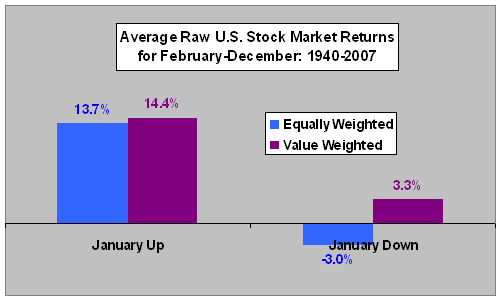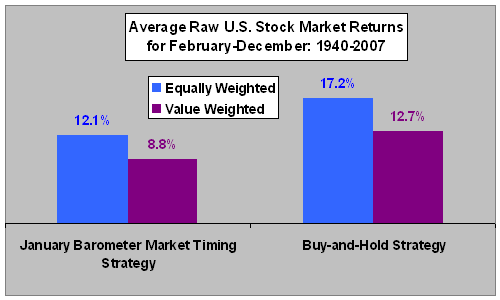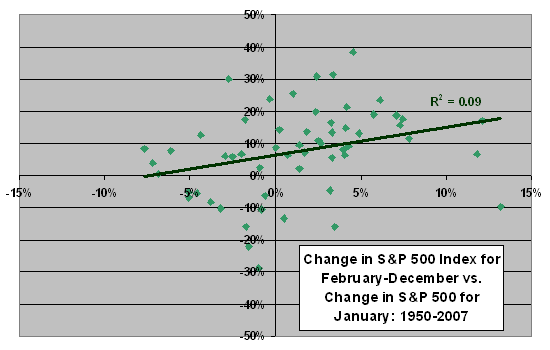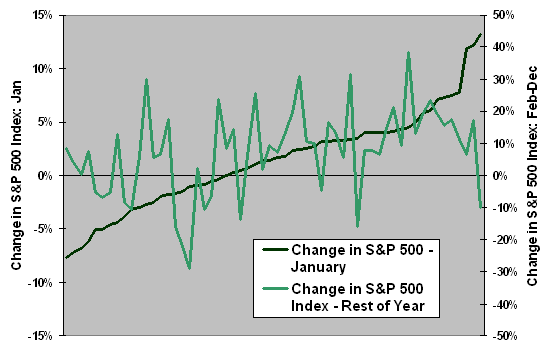As goes January, so goes the rest of the year? In the November 2008 update of their paper entitled “The Illusionary Market Timing Ability of the Other January Effect”, Ben Marshall and Nuttawat Visaltanachoti examine the ability of January returns to predict February-December returns and support a market timing strategy in the U.S. and other equity markets. They consider multiple robustness tests to determine the statistical and economic significance of this January Barometer based on both equally weighted and value weighted returns. Using U.S. stock return data spanning 1925-2007 (focusing on 1940-2007) and stock return data for 18 other countries and the world spanning 1970-2007, they conclude that:
- On average, February-December U.S. stock market returns are significantly higher following positive Januaries than negative Januaries (see the first chart below). However, the difference between average February-December returns following up and down Januaries is statistically significant in only four of 18 other countries.
- Furthermore, a simple trading strategy based solely on the January Barometer underperforms a buy-and-hold strategy for U.S. equity indexes, international equity indexes and portfolios of stocks of different sizes (see the second chart below).
- The January Barometer underperformance derives from: (1) the large opportunity cost of missing abnormally high January returns while awaiting January barometer readings; and, (2) the poor performance of the January barometer as a signal to short the market during February-December.
- The January Barometer has no predictive power when applied to individual stocks.
The following chart, constructed from data in the paper, summarizes January Barometer performance using both equally weighted and valued weighted returns for a very broad sample of U.S. stocks over the period 1940-2007 (before trading frictions). It shows that, on average, the indicator does predict February-December outperformance and underperformance. The statistical significance is strong and survives robustness tests.

The next chart, also constructed from data in the paper, compares the performance of a simple market timing strategy based solely on the January Barometer to a buy-and-hold strategy for a very broad sample of U.S. stocks over the period 1940-2007 (before trading frictions). The January Barometer market timing strategy is in Treasury bills in January and then is either long or short the stock market during February-December each year, according to whether January is an up or down month. It shows that, on average, the simple market timing strategy underperforms a comparable buy-and-hold strategy based on both equally weighted and value weighted returns. Sharpe ratios for the January Barometer market timing strategy are also lower than those for the buy-and-hold strategy for both weightings.
An alternative January Barometer market timing strategy that is in stocks rather than Treasury bills in January also underperforms a buy-and-hold strategy because of the drag of poor-performing short positions after down Januaries.

In summary, evidence indicates that an up/down January is predictive of February-December outperformance/underperformance for the broad U.S. stock market (but not for most other equity markets). However, it may not support an effective market timing strategy as a standalone signal.
As a separate test on a widely followed U.S. index, we use monthly returns for the S&P 500 index (based on monthly opening and closing levels) for 1950-2007 to relate the change in the index for February-December to the change for January. The following scatter plot depicts the results. The Pearson correlation between the two series is 0.30 and the R-squared statistic is 0.09, suggesting that the January return explains 9% of the return for the balance of the year.
Are some parts of the January return distribution more reliably predictive than others?

The next plot recasts the data in the prior one by ordering the S&P 500 index returns for January from lowest (-7.6%) to highest (+13.2%) for 1950-2007. The horizontal axis is therefore not time-sequential. This view of the data suggests that the January Barometer holds mostly for intermediate values of January returns. At the extreme tails of the January return distribution, returns for the rest of the year do not track January results.
